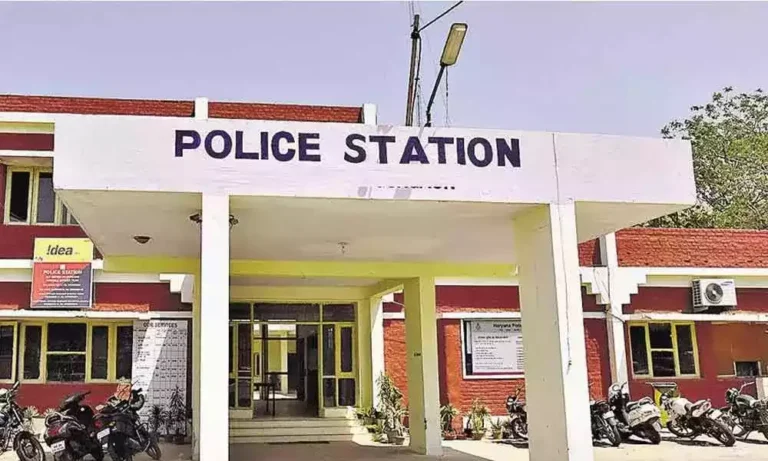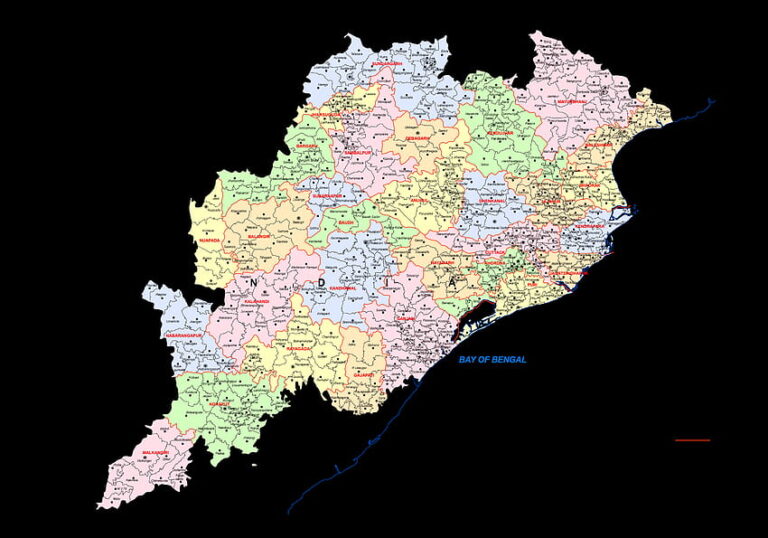Odisha Geography: Exploring the Enchanting Land of Natural Wonders(2023)
Odisha Geography, where nature showcases its finest creations and history weaves an intriguing tapestry. Odisha, a land of diverse beauty and cultural heritage, is nestled on the eastern coast of India. Blessed with a varied geography, this Indian state offers a mesmerizing blend of beaches, forests, plateaus, waterfalls, and historic landmarks.
Location Overview
Odisha Geography lies between the latitudes 17.780N and 22.730N, and between longitudes 81.37E and 87.53E. The state has an area of 155,707 km2, which is 4.87% of the total area of India, and a coastline of 450 km. It is bounded by the Bay of Bengal in the east, Jharkhand and West Bengal in the north, Chhattisgarh in the west, and Andhra Pradesh in the south side. In the eastern part of the state lies the coastal plain. It extends from the Subarnarekha River in the north to the Rushikulya River in the south.

Odisha Geography: A Historical Perspective
The geographical features of Odisha are deeply intertwined with its rich history, making it a land of historical significance and cultural heritage.
1. Temples of Odisha: Architectural Marvels
Odisha is famous for its ancient temples, each a masterpiece of architecture and a testament to the state’s religious heritage. The Konark Sun Temple, Lingaraja Temple, and Jagannath Temple are some of the finest examples of Odishan temple architecture.
2. The Influence of Buddhism: Peaceful Vistas
The land of Odisha has been a significant center for Buddhist activities. Explore the Ratnagiri and Udayagiri caves, where the serenity of Buddhism can still be felt.
3. The Legacy of Kalinga: A Turning Point in History
Odisha was the site of the historic Kalinga War, which transformed Emperor Ashoka from a conqueror to a compassionate ruler. Discover the impact of this pivotal event on India’s history and the spread of Buddhism.
Odisha Geography: A Journey Through Time
The geography of Odisha holds within its folds the tales of ancient civilizations, invasions, and the evolution of culture over centuries.
1. Prehistoric Wonders: Traces of an Ancient Past
Delve into the prehistoric sites of Odisha, where archaeological discoveries shed light on the region’s early inhabitants and their way of life.
2. Maritime Trade: The Gateway to the East
Odisha’s coastline has been a hub for maritime trade since ancient times. Learn about its significance in connecting India to Southeast Asia and beyond.
3. Colonial Influences: Odisha Under Foreign Rule
Discover the impact of European colonization on Odisha and how it shaped the state’s culture and governance.
Physical divisions Of Odisha Geography
Odisha can be divided into five major Physiographic regions based on continuity, homogeneity, and other physiographical characteristics:
The Odisha Coastal Plains
The Odisha Coastal Plains are sedimentary landforms of recent origin. Geologically they belong to the Paleogene and Neogene ages (approximately 65 to 2.6 million years ago). Their western boundary is at around 250 feet eastern ghats and they have a nearly straight shoreline in the east. This region stretches from the Subarnarekha basin in the north to the Rushikulya basin in the south.
A major part of this region is formed by deltas of the six major rivers i.e. the Mahanadi, the Brahmani, the Budhabalanga, the Subarnarekha, the Baitarani, and the Rushikulya. This has given rise to the names such as the “Gift of Six Rivers” or the “Hexadeltaic region”. It spans along the coast of the Bay of Bengal with the maximum width near the Mahanadi Delta (the Middle Coastal Plain). It is narrower in the Northern Coastal Plain in Baleshwar District (also called Balasore Plain) and narrowest in the Southern Coastal Plain in Ganjam District (called Ganjam Plain).
Middle mountainous and highlands region
The middle mountainous and highlands region is the largest of the geographic regions and covers about three-fourths of the state. The region mostly comprises the hills and mountains of the Eastern Ghats which rise sharply in the east and slope gradually to the eroded plateaus in the west running from the northwest (Mayurbhanj) to the southwest (Malkangiri). Geologically the formation is quite old. It is a part of the Indian Peninsula which was a part of the ancient landmass of Gondwanaland.
The rivers of Odisha and their tributaries have cut deep and narrow valleys in this region. The Odisha highlands are also known as the Garhjat Hills. This region is well-marked by a number of watersheds. A number of river valleys of varying width and flood plains dissect the Eastern Ghats in this region. The average height of this region is about 900 meters above the mean sea level. The highest peak is Deomali.
Central plateaus
The plateaus are part of the western slopes of the Eastern Ghats. They are mostly eroded plateaus with elevations varying from 305 to 610 meters. There are two broad plateaus: (i) the Panposh-Keonjhar Pallahara plateau comprises the Upper Baitarani catchment basin in the northern part of the state, and (ii) the Nabrangpur-Jeypore plateau comprises the Sabari basin in the southern part of the state.
Western rolling uplands
The western rolling uplands have heights varying from 153 meters to 305 meters. These are lower in elevation than the plateaus. It consists of the following geographically distinct uplands.
1. The Rairangpur rolling upland – This region encompasses the northern part of the Mayurbhanj district. The uplands are a part of the Subarnarekha basin and slopes towards the north.
2. The Keonjhar rolling upland – This region is part of Kendujhar district and lies at the edge of Keonjhar Plateau. It is part of the Baitarani River basin.
3. The Rourkela rolling upland – This is part of Sundergarh district and lies on the Upper Brahmani basin.
4. The Bolangir-Bargarh-Rairkhol rolling upland – This is part of multiple districts and lies on the Upper Mahanadi and its tributaries basin.
4. The Aska rolling upland – This is situated in Ganjam District on the Upper Rushikulya basin.
5. The Rayagada rolling upland – This upland is part of the Rayagada district and lies on the Nagavali and the Vansadhara river basins.
6. The Malkangiri rolling upland – Located on the southern tip of Odisha, this upland is situated on the Sabari-Machhkund basins of the Dandakaranya Region.
Major Flood Plains
These flood plains are formed due to major rivers in the highlands, uplands, and plateaus. The height varies from 75 to 153m. The nine major flood plains of Odisha are:
1.Baripada flood plain
2.Anandapur flood plain
3. Talcher floodplain
4. Bhuban floodplain
5. Sonepur floodplain
6. Athagarh flood plain
7. Aska floodplain
8.Rayagada flood plain
9.Malkangiri flood plain
Exploring the Magnificent Forests
Odisha is home to several wildlife sanctuaries and national parks, making it a paradise for nature lovers and wildlife enthusiasts. The Simlipal National Park, Bhitarkanika Wildlife Sanctuary, and Satkosia Tiger Reserve are among the prominent ones.
The state’s forests are teeming with diverse flora and fauna, including rare species like the Royal Bengal Tiger and Asian Elephant.
Rivers of Odisha Geography

Most of the major rivers of Odisha flow eastwards and ultimately empty into the Bay of Bengal.
Rivers that originate outside Odisha
1. Mahanadi River
The Mahanadi River originates from the Sihawa range of hills in the Dhamtari district of Chhattisgarh. Flowing gracefully through the fertile plains of the state and into the heart of Odisha, it covers a total length of approximately 851 kilometers. It is the widest river in Odisha.
2. Brahmani River
The Brahmani is a major seasonal river in the Odisha state of eastern India. The Brahmani is formed by the confluence of the Sankh and South Koel rivers and flows through the districts of Sundargarh, Deogarh, Angul, Dhenkanal, Cuttack, Jajapur and Kendrapara. Also, South Koel can be considered as the upper reaches of Brahmani. Together with the river Baitarani, Brahmani forms a large delta before emptying into the Bay of Bengal at Dhamra. It is the second-widest river in Odisha.
3. Subarnarekha River
The Subarnarekha River takes its birth from the Chota Nagpur Plateau in the state of Jharkhand. It flows through the mineral-rich regions of the state before entering the coastal plains of Odisha, covering a total distance of approximately 395 kilometers.
4. Ib River
The Ib River finds its source in the picturesque hills of Chattisgarh. Flowing gracefully through dense forests, it covers a distance of approximately 529 kilometers, nurturing the land with its life-giving waters.
Rivers originating in Odisha
1. Baitarani River
The Baitarani River takes its birth in the hills of Odisha. Gracefully flowing through lush green valleys, it covers a distance of approximately 360 kilometers, nurturing the land with its life-sustaining waters
2. Budhabalanga River
The Budhabalanga River finds its source in the pristine hills of Odisha. Meandering gracefully through verdant valleys, it covers a distance of approximately 175 kilometers, enriching the land with its life-giving waters.
3. Salandi River
The Salandi River finds its genesis in the pristine hills of Odisha. Gracefully flowing through picturesque valleys, it covers a distance of approximately 220 kilometers, nurturing the land with its life-giving waters.
4. Rushikulya River
The Rushikulya River takes its birth in the scenic landscapes of Odisha. Gracefully meandering through picturesque terrain, it covers a distance of approximately 165 kilometers, nurturing the land with its life-giving waters.
Rivers that originate inside Odisha, but flow through other states
1. Bahuda River
The Bahuda River takes its birth in the scenic landscapes of Odisha. Gracefully meandering through picturesque terrain, it covers a distance of approximately 150 kilometers, nurturing the land with its life-giving waters.
2. Vamsadhara River
The Vamsadhara River finds its birth in the scenic landscapes of Odisha. Gracefully flowing through diverse terrain, it covers a distance of approximately 254 kilometers, nourishing the land with its life-giving waters.
3. Nagavali River
The Nagavali River takes its birth in the scenic landscapes of Odisha. Gracefully flowing through diverse terrain, it covers a distance of approximately 256 kilometers, nurturing the land with its life-giving waters.
Rivers originate inside Odisha but are tributaries of rivers that flow through other states
1. Machkund River
The Machkund River takes its birth in the scenic landscapes of Odisha. Gracefully flowing through diverse terrain, it covers a distance of approximately 300 kilometers, nurturing the land with its life-giving waters.
2. Sileru River
The Sileru River takes its birth in the majestic landscapes of Odisha. Gracefully flowing through diverse terrain, it covers a distance of approximately 230 kilometers, nurturing the land with its life-giving waters.
3. Kolab River
The Kolab River takes its birth in the enchanting landscapes of Odisha. Gracefully flowing through diverse terrain, it covers a distance of approximately 245 kilometers, nurturing the land with its life-giving waters.
4. Indravati River
The Indravati River takes its birth in the captivating landscapes of Odisha. Gracefully flowing through diverse terrain, it covers a distance of approximately 535 kilometers, nurturing the land with its life-giving waters.
Lakes of Odisha Geography
1. Chilika Lake
Chilika Lake is a brackish water lagoon located in the southern part of the Odisha coastal plain. It is India’s largest coastal lagoon and is spread across the districts of Ganjam, Khurda, and Puri. Its area varies between 900 km2 and 1165 km2; during the two monsoon months, it is 71 km long and 32 km wide. Its salinity decreases to a minimum during the monsoon. However, in winter, due to the overflow of the tidal water through the narrow opening from the Bay of Bengal, the lake reaches its maximum height. It is a Ramsar Convention-protected wetland and hosts around 33 species of migratory and local birds.
2. Anshupa Lake
Anshupa Lake is a picturesque freshwater lake situated in the Mahanadi River basin in the state of Odisha, India. This lake is known for its natural beauty and serene surroundings, making it a popular tourist destination. Anshupa Lake is renowned for its stunning beauty, serene ambiance, and rich ecological diversity, making it a popular destination for nature enthusiasts, tourists, and birdwatchers.
3. Sara
Sara is a freshwater lake located near Puri. It is 5 km long and 3 km wide. Four distributaries of the Mahanadi River system, the Bhargavi, the Kushabhadra, the Mugei, and the Dhanua drain into the lake
4. Kanjia
Kanjia Lake is another freshwater lake with about 134 acres (0.54 km2) of area located in Nandankanan of Khorda district near Bhubaneswar.
5. Tampara
Tampara is another freshwater lake located alongside the town of Chatrapur. It is 4 km long and 0.5 km wide. It is fed by the backwater of Rushikulya River in the monsoon season.
Artificial Water Reservoirs of Odisha Geography
1. Hirakud Dam
Hirakud Dam is an Artificial Lake in Sambalpur and Jharsuguda largest artificial lake in Asia. Hirakud Dam, an engineering marvel nestled in the state of Odisha, stands as a testament to human ingenuity and resilience. Proudly resting on the Mahanadi River, this grand structure has transformed the landscape and the lives of the people it serves. The Hirakud Dam’s significance in water management, power generation, and economic growth has made it an essential part of India’s development journey.
2. Indravati Dam
Indravati Dam, an engineering marvel nestled in the picturesque landscapes of Odisha, stands tall as a testament to human ingenuity and progress. Proudly harnessing the power of the Indravati River, this grand structure has transformed the region’s landscape and the lives of the people it serves. The Indravati Dam’s significance in water management, power generation, and economic growth has made it an essential part of the region’s development journey.
3. Kolab Dam
Kolab Dam is an Artificial Lake in Koraput. Kolab Dam, an engineering feat nestled amidst the serene landscapes of Odisha, stands as a testament to human innovation and progress. Proudly harnessing the power of the Kolab River, this magnificent structure has transformed the region’s landscape and the lives of the people it serves. The Kolab Dam’s significance in water management, irrigation, and hydroelectric power generation has made it a vital component of the region’s development journey.
4. Rengali Dam
Rengali Dam is a dam that has been constructed across the river Brahmani at Rengali in Angul. Rengali Dam, an engineering marvel located in the picturesque landscapes of Odisha, stands as a testament to human innovation and progress. Proudly harnessing the power of the Brahmani River, this impressive structure has transformed the region’s landscape and the lives of the people it serves. The Rengali Dam’s significance in water management, irrigation, and hydroelectric power generation has made it a vital component of the region’s development journey.
The Majestic Waterfalls of Odisha Geography
| Name of Waterfall | Rivers /tributary etc. | Height | Location |
|---|---|---|---|
| Putudi | River Salunki,a tributary to Mahanadi | 60 ft (18 m) | Phulbani |
| Bada Ghagra | Machhakandana river, a tributary to the Baitarani | 200 ft (61 m) | Kendujhar |
| San Ghagra | Machhakandana river, a tributary to the Baitarani | 100 ft (30 m) | Kendujhar |
| Khandadhar | A tributary to the Brahamani | 500 ft (150 m) | Kendujhar |
| Bhimkund | The Baitarani | Kendujhar | |
| Barehipani | Budhabalanga | 1,309 ft (399 m) | Mayurbhanj |
| Joranda | Budhabalanga | 490 ft (150 m) | Mayurbhanj |
| Debakunda | 50 ft (15 m) | Mayurbhanj | |
| Pradhanpat | A tributary of the Brahamani | 30 ft (9.1 m) | Deogarh |
| Phurlijharan | A tributary of the Indravati | 49 ft (15 m) | Bhawanipatna, Kalahandi |
| Dokaridhara | 200 ft (61 m) | Kalahandi | |
| Bhanyaraghumara | 150 ft (46 m) | Kalahandi | |
| Rabandhara | 45 ft (14 m) | Kalahandi | |
| Khandadhar | Korapani Nala, a tributary of the Brahamani | 801 ft (244 m) | Bonei, Sundergarh |
| Nrushingh Nath(Bhimdhar) | A tributary of the Tel | Bargarh | |
| Harishankar | Jira river, a tributary of the Tel | Bolangir | |
| Koilighugar | Ahiraj, a tributary of the Mahanadi | 200 ft (61 m) | Jharsuguda |
| Duduma | Machakund river a tributary of the Godavari | 574 ft (175 m) | Koraput |
| Gandahati | Mahendratanaya | 65 ft (20 m) | Gajapati |
FAQ
What is the geography of Odisha?
Odisha Geography lies between the latitudes 17.780N and 22.730N, and between longitudes 81.37E and 87.53E. The state has an area of 155,707 km2, which is 4.87% of the total area of India, and a coastline of 450 km.
What is the old name of Odisha?
Utkala and Kalinga
What are the 4 bordering states of Odisha?
Odisha is surrounded by 4 states: Andhra Pradesh from the south, Chhattisgarh from the west, and Jharkhand and West Bengal from the north.
Why is Odisha famous?
Odisha is famous for:
1. Lord Jagarnath Temple, Konark Temple
2. Rath Yatra
3. Sea beaches: Puri, Konark, chandipur
4. And its heritage sites, beaches, temples, natural parks, foods, and culture.
Who is the first king of Odisha?
Odisha’s first king, Kapilendra (1435–66), won territories from his Muslim neighbors and greatly expanded the Kalinga kingdom.
What makes Odisha’s coastline unique?
Odisha’s coastline is unique for its pristine beaches and the famous Jagannath Temple in Puri, a sacred pilgrimage site for Hindus.






